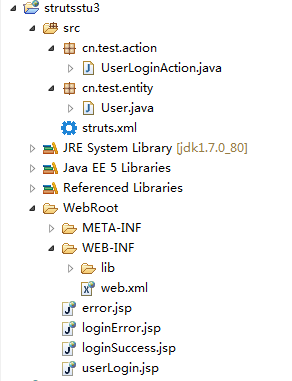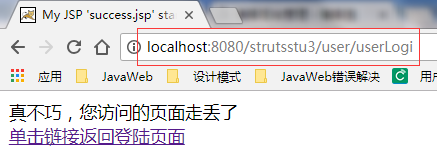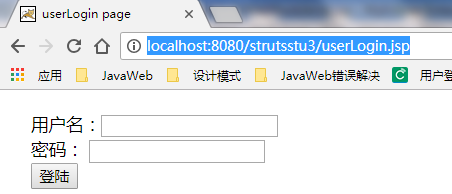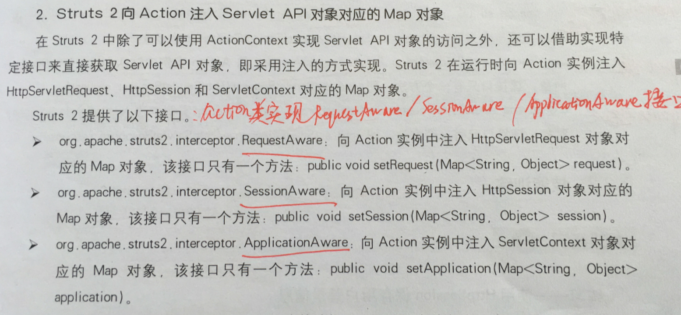Struts2基础-3 -继承ActionSupport接口创建Action控制器+javaBean接收请求参数+ 默认Action配置处理请求错误 + 使用ActionContext访问ServletAPI
1.目录结构及导入的jar包


2.web.xml 配置
1 <?xml version="1.0" encoding="UTF-8"?> 2 <web-app version="2.5" xmlns="http://java.sun.com/xml/ns/javaee" 3 xmlns:xsi="http://www.w3.org/2001/XMLSchema-instance" 4 xsi:schemaLocation="http://java.sun.com/xml/ns/javaee 5 http://java.sun.com/xml/ns/javaee/web-app_2_5.xsd"> 6 <welcome-file-list> 7 <welcome-file>index.jsp</welcome-file> 8 </welcome-file-list> 9 10 <filter> 11 <filter-name>StrutsPrepareAndExecuteFilter</filter-name> 12 <filter-class>org.apache.struts2.dispatcher.ng.filter.StrutsPrepareAndExecuteFilter</filter-class> 13 </filter> 14 15 <filter-mapping> 16 <filter-name>StrutsPrepareAndExecuteFilter</filter-name> 17 <url-pattern>/*</url-pattern> 18 </filter-mapping> 19 20 </web-app>
2.Action类编写
User JavaBean定义
1 package cn.test.entity; 2 3 public class User { 4 5 private String name; 6 private String age; 7 private String password; 8 9 public String getAge() { 10 return age; 11 } 12 13 public void setAge(String age) { 14 this.age = age; 15 } 16 17 public String getName() { 18 return name; 19 } 20 21 public void setName(String name) { 22 this.name = name; 23 } 24 25 26 public String getPassword() { 27 return password; 28 } 29 30 public void setPassword(String password) { 31 this.password = password; 32 } 33 34 @Override 35 public String toString() { 36 return "User [age=" + age + ", name=" + name + ", password=" + password 37 + "]"; 38 } 39 40 }
通过继承ActionSupport类创建 Action控制器:
(1)不管是通过Javabean 还是直接通过属性字段获取请求数据,都需要在Action类设置setter getter方法
(2)ActionSupport类实现了Action接口,所以此处可以选择重写execute() 方法,处理请求
(3)此处通过ActionContext类访问Servlet API,获取session对象
1 package cn.test.action; 2 3 import cn.test.entity.User; 4 5 import com.opensymphony.xwork2.Action; 6 import com.opensymphony.xwork2.ActionContext; 7 import com.opensymphony.xwork2.ActionSupport; 8 9 /** 10 * Action处理请求参数-属性驱动 strtus2中页面的请求数据和Action有两种基本的对应方式,分别是字段驱动和模型驱动方式。字段驱动也叫属性驱动 11 * 属性驱动是指通字段进行数据传递,包括:与基本数据类型的属性对应,直接使用域对象(也就是javaBean) 12 * 13 * @author Administrator 14 * 15 */ 16 public class UserLoginAction extends ActionSupport { 17 18 private static final long serialVersionUID = 1L; 19 private User user;// 通过javaBean获取前端传递的数据;必须设置getter setter方法 20 21 public User getUser() { 22 return user; 23 } 24 25 public void setUser(User user) { 26 this.user = user; 27 } 28 29 @Override 30 public String execute() throws Exception { //继承ActionSupport接口的Action类中,必须要有重写的execute方法 31 //获取Context对象: 通过ActionContext类访问Servlet API 32 ActionContext context = ActionContext.getContext(); 33 if("admin".equals(user.getName()) && "123".equals(user.getPassword())){ 34 //把用户名和密码放到session中 35 context.getSession().put("username", user.getName()); 36 context.getSession().put("password", user.getPassword()); 37 return Action.SUCCESS; 38 } else { 39 context.getSession().put("error", "用户登陆失败"); 40 return ERROR;//Action接口中定义的常量 41 } 42 43 } 44 45 46 47 }
3. struts.xml中 action的配置
当Action类返回“success”逻辑视图名,请求转发到loginSuccess.jsp 页面,当返回error 逻辑视图名,请求转发到 loginError.jsp 页面。
红色部分是配置了一个默认的action,当请求一个不存在的action时,一般页面会报404 not found,当我们配置默认的action,如果请求一个不存在的aciton时,页面就会跳转到
我们指定的错误页面,而不是提示404, 此处跳转到error.jsp 页面
1 <?xml version="1.0" encoding="UTF-8"?> 2 <!DOCTYPE struts PUBLIC 3 "-//Apache Software Foundation//DTD Struts Configuration 2.3//EN" 4 "http://struts.apache.org/dtds/struts-2.3.dtd"> 5 <struts> 6 <!-- 开启动态调用,并且设置启用开发者模式 --> 7 <constant name="struts.enable.DynamicMethodInvocation" value="true"></constant> 8 <constant name="struts.devMode" value="true"></constant> 9 10 <!-- 配置默认的action,当请求一个不存在的Action,将跳转到error.jsp页面--> 11 <package name="default" namespace="/user" extends="struts-default"> 12 <default-action-ref name="defaultAction"></default-action-ref> 13 <action name="defaultAction"> 14 <result>/error.jsp</result> 15 </action> 16 </package> 17 18 <package name="user" namespace="/user" extends="struts-default"> 19 <action name="userLogin" class="cn.test.action.UserLoginAction"> 20 <result name="success">/loginSuccess.jsp</result> 21 <result name="error">/loginError.jsp</result> 22 </action> 23 </package> 24 </struts>
4. JSP页面编写
登录页面userLogin.jsp(浏览器直接请求该页面,进入到登陆页面):
1 <%@ page language="java" import="java.util.*" pageEncoding="UTF-8"%> 2 3 <% 4 String path = request.getContextPath(); 5 String basePath = request.getScheme()+"://"+request.getServerName()+":"+request.getServerPort()+path+"/"; 6 %> 7 8 <!DOCTYPE HTML PUBLIC "-//W3C//DTD HTML 4.01 Transitional//EN"> 9 <html> 10 <head> 11 <base href="<%=basePath%>"> 12 <title>userLogin page</title> 13 </head> 14 <body> 15 <div style="margin:10px;padding:10px"> 16 <form name="fomr1" action="<%=basePath%>user/userLogin.action" method="post"> 17 用户名:<input type="text" name="user.name" /><br/> 18 密码: <input type="password" name="user.password" /><br/> 19 <input type="submit" value="登陆" /> 20 </form> 21 </div> 22 </body> 23 </html>
登陆成功页面
1 <%@ page language="java" import="java.util.*" pageEncoding="UTF-8"%> 2 <%@ taglib uri="/struts-tags" prefix="s"%> 3 <% 4 String path = request.getContextPath(); 5 String basePath = request.getScheme() + "://" 6 + request.getServerName() + ":" + request.getServerPort() 7 + path + "/"; 8 %> 9 10 <!DOCTYPE HTML PUBLIC "-//W3C//DTD HTML 4.01 Transitional//EN"> 11 <html> 12 <head> 13 <base href="<%=basePath%>"> 14 <title>My JSP 'success.jsp' starting page</title> 15 </head> 16 17 <body> 18 登陆成功,session中的登陆用户名是:<%=request.getAttribute("user.name") %><br> 19 <!--<s:property value="name"/> value里面写上Action类中定义的属性,就能在jsp页面显示请求中所带的参数了 --> 20 采用OGNL与Struts2标签输出Action类的属性值(Action类获取到的请求参数值) <br/> 21 name=<s:property value="user.name" /> password=<s:property value="user.password" /> <br> 22 采用EL表达式 输出Action类的属性值(${对象名.属性名 }):<br> 23 name=${user.name } 24 </body> 25 </html>
登陆失败页面
1 <%@ page language="java" import="java.util.*" pageEncoding="UTF-8"%> 2 <%@ taglib uri="/struts-tags" prefix="s"%> 3 <% 4 String path = request.getContextPath(); 5 String basePath = request.getScheme() + "://" 6 + request.getServerName() + ":" + request.getServerPort() 7 + path + "/"; 8 %> 9 10 <!DOCTYPE HTML PUBLIC "-//W3C//DTD HTML 4.01 Transitional//EN"> 11 <html> 12 <head> 13 <base href="<%=basePath%>"> 14 <title>登陆失败页面</title> 15 </head> 16 17 <body> 18 控制器返回的错误信息为:${error };<br> 19 <a href="userLogin.jsp">单击链接返回登陆页面</a> 20 </body> 21 </html>
默认Action指定的跳转页面
1 <%@ page language="java" import="java.util.*" pageEncoding="UTF-8"%> 2 <% 3 String path = request.getContextPath(); 4 String basePath = request.getScheme() + "://" 5 + request.getServerName() + ":" + request.getServerPort() 6 + path + "/"; 7 %> 8 9 <!DOCTYPE HTML PUBLIC "-//W3C//DTD HTML 4.01 Transitional//EN"> 10 <html> 11 <head> 12 <base href="<%=basePath%>"> 13 <title>My JSP 'success.jsp' starting page</title> 14 </head> 15 <body> 16 真不巧,您访问的页面走丢了<br> 17 <a href="userLogin.jsp">单击链接返回登陆页面</a> 18 </body> 19 </html>
部署测试:
(1)输入一个访问不到的请求:http://localhost:8080/strutsstu3/user/userLogi ,此时处理请求的是默认Action

(2) 单击上一步的链接, 转到 http://localhost:8080/strutsstu3/userLogin.jsp

输入admin 和一个错误的密码,结果如下:

单击链接返回登陆页,输入admin 和123 提交,结果如下

注:
(1)在使用Javabean属性方式传值时,如果JSP页面时负责取值的,那么取值的格式必须为“对象.属性名”;如果JSP页面时负责传值的,那么传值的格式可以为“对象.属性名”,也可以直接是“属性名”;
(2)Struts2的Action没有与ServletAPI发生耦合,但是web开发中经常会用到ServletAPI中的对象,如用户登陆成功,则应该将用户信息保存到HttpSession中,而最常用的ServletAPI就是HttpSession, HttpServletRequest、ServletContext这三个接口,Strtus2访问ServletAPI,可以分为2类:与Servlet API 解耦的访问方式和与servlet API耦合的访问方式。
与Servlet API 解耦的访问方式:
(a)使用ActionContext类获取Servlet 对象对用的Map对象


例如:
ActionContext context = ActionContext.getContext();
Map request = (Map) context.get("request");//ActionContext类没有提供getRequest()这样的方法来获取HttpServletRequest对应的map对象,要想得到HttpServletRequest对象对应的map对象,需要为get()方法传递request参数
context.put("username", "admin"); //放到request作用域,相当于ServletAPI中国年的HttpServletRequest的setAttribute()方法
context.getSession().put("username", "admin"); // 把信息放到session作用域
context.getApplication().put("username", "admin"); // 把信息放到Application 作用域
(b) 实现特定接口获取Servlet API对象

与Servlet API 耦合的访问方式:


示例代码下载地址 https://github.com/liuch0228/Struts2SSH.git


